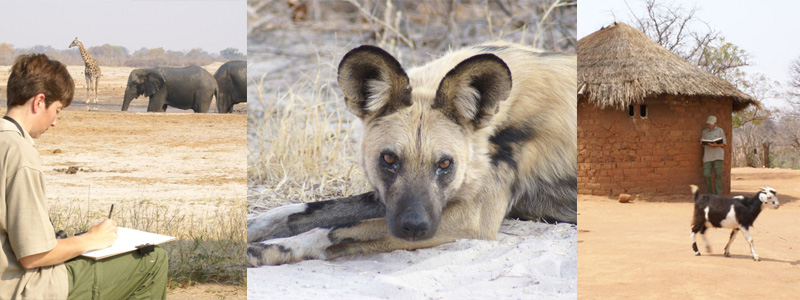Painting the Painted Dogs – an Artistic Study of an Endangered Hunter

In 2007 I spent 6 weeks with Painted Dog Conservation (PDC) in Zimbabwe, tracking and sketching highly endangered African Wild Dogs, also known as Painted Dogs, and learning about PDC’s extensive educational programs and work with local communities. My visit was funded by an Artists For Conservation grant under their Flag Expeditions program, and my expedition was titled Painting the Painted Dogs – an Artistic Study of an Endangered Hunter. On my return home I created a traveling exhibition and lecture series, featuring sketches from my expedition journal, studio paintings, photographs and video from my expedition. 25% of sales from the exhibition and 100% of lecture fees were donated to PDC and I continue to donate a percentage from every Painted Dog artwork to support the conservation of this unique predator.

Painted Dogs
In Zimbabwe African wild dogs (Lycaon pictus) are often called painted dogs, with the term ‘painted’ being taken from their scientific name ‘pictus’. The name African wild dog came about during a time when most large predators were being systematically exterminated by people and conjures up a picture of a feral species and a vicious killer. In fact, painted dogs are one of the most ancient and unique canids, not closely related to wolves, domestic dogs or jackals. (Or hyenas, which are not dogs at all but more closely related to civets and mongooses.) In recent years, painted dogs have become one of the most sought-after sightings on safari and once they have encountered these distinctive and often elusive dogs, most people are intrigued by them. The dogs are built for endurance, with a slim frame and long slender legs. They are beautifully and individually marked in black, tan and white, with white-tipped tails, a dark muzzle, almond eyes and huge round ears. Fights within (or even between) packs are rare and they are truly one of the most sociable predators. The whole pack cares for pups once they leave the den, and the pack will also regurgitate food for sick or injured adults who cannot join the hunt.

Painted dogs chasing a spotted hyena. Elephant asserting it’s right of way over the dogs.
Painted dog numbers have dropped dramatically from between 300,000 – 500,000 in 1900 to less than 7,000 today. They have vanished from 25 of the 39 countries forming their historical range and are on the International Union for Conservation of Nature & Natural Resources (IUCN) list of endangered species. Zimbabwe contains one of the last viable dog populations. Threats to their continued survival vary in different countries, but in Zimbabwe the main threats are snares (set to catch animals like antelope for bushmeat), diseases like rabies and canine distemper, and road traffic accidents. However, across their entire range, habitat destruction is the main concern.

Visiting PDC deepened my interest in conservation and opened my eyes to the daily trials faced by organizations working in the field. It sparked my interest in field sketching and plein air painting, and inspired the creation of my 1st conservation-themed studio painting, Ensnared. I was determined to repeat this wonderful experience and a few years later I undertook a similar project with African People & Wildlife in Tanzania.
Conservation-themed paintings based on my visit to PDC. Click on the images to read more about these paintings.